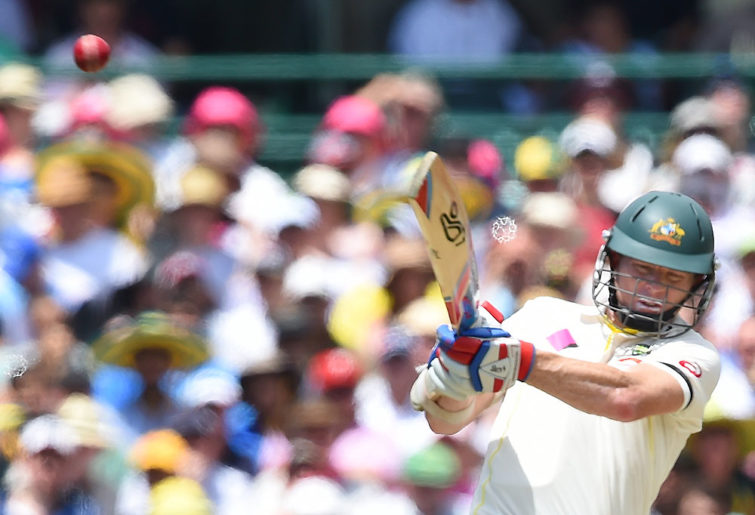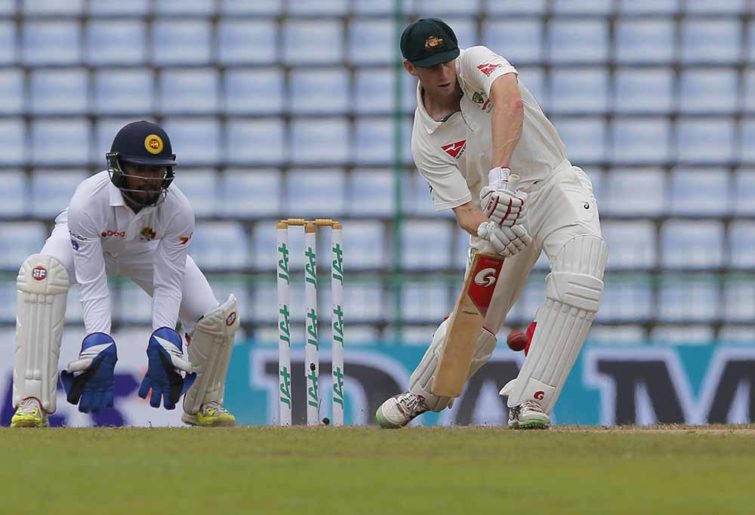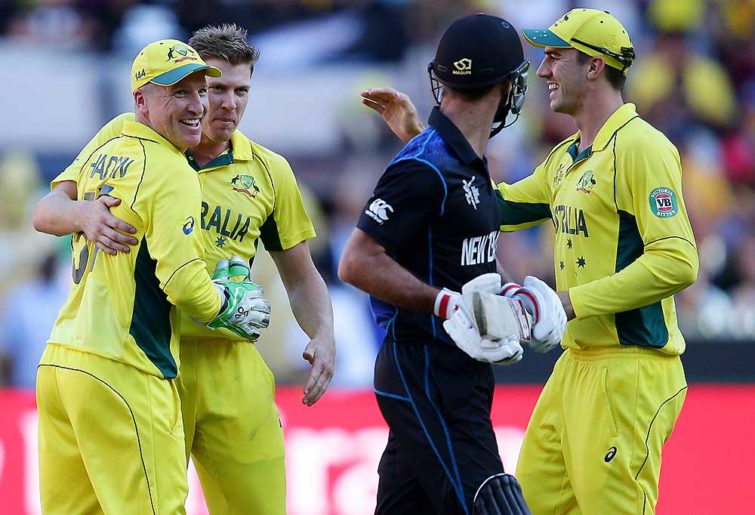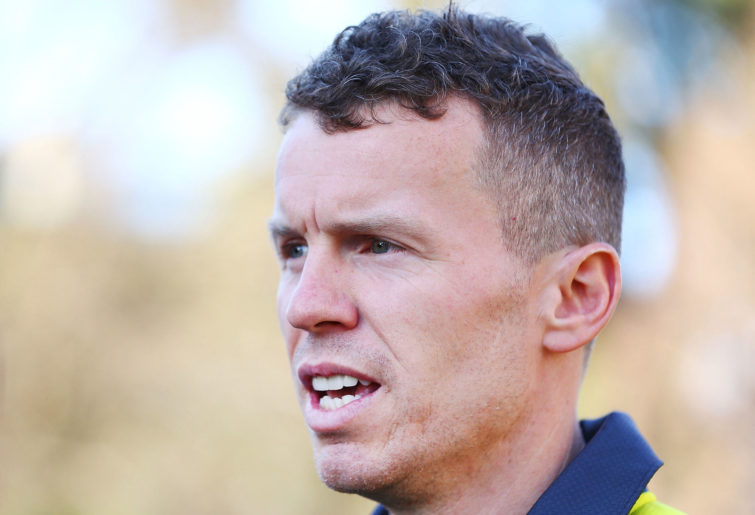Over the years, the game of cricket has produced its superstars and megastars. Volumes have been written about these stars.
But then there are also players who have manfully served their team without receiving the deserved recognition.
Here I have selected an Australian XI of unsung heroes I have seen in my lifetime, chiefly in Test cricket.
Chris Rogers
Given that he ended his career with a Test average of 42.87 and a first-class average of almost 50, it seems strange that he was almost 36 when he first established himself in the Australian team.
Over the next two years, he did his best to make up for the lost time. After scoring his maiden Test hundred at the relatively new venue of Chester-Le-Street, he usually reserved his best for the bigger venues. He finished the Australian summer of 2013-14 with back-to-back Ashes hundreds at the MCG and SCG.
And then in the 2015 tour, he scored a fine 173 at Lord’s. The Aussies thrashed their opponents after Rogers and Steve Smith had batted their opponents out of the match on the first day of the Test.
In between his Ashes success, there was a string of fifties against India, which gave a big boost to his Test average.

(AAP Image/Dean Lewins)
Geoff Marsh
In contrast to Rogers’ records, Marsh’s averages of 33.18 in Tests and 39.97 in first-class cricket seems quite modest. But his main contribution was in offering some stability up the order during a turbulent period in Aussie cricket history.
After failing to impress as a No.3 in his first two Tests against India in 1985-86, he was tried as an opening bat for the third match at the SCG. After India declared at 4/600 late on the second day, Marsh accompanied his partner David Boon – himself fairly unfamiliar in the opening role.
Nevertheless, the two frustrated the Indian spinners for almost six hours. And their 217-run opening partnership combined with some timely rain interventions was enough to ensure the home side’s safety in the match. While Boon scored a fine ton – his second in the series – Marsh fell short by just eight runs.
He was obviously disappointed, but within the next 12 months he scored three Test hundreds. The best of those was possibly the Ashes hundred at the Gabba for a losing cause. The Aussies lost the Ashes, but with Dean Jones establishing himself in the No.3 slot, the Aussie top order finally got a settled look about it.
Sadly, Marsh failed to achieve the level of consistency at the Test level expected of an opener. His only other Test hundred, at Trent Bridge in the English summer of 1989, virtually went unnoticed as all the Aussie batsmen were scoring freely against a hapless English attack.
Marsh’s first Ashes match had ended in defeat at the Gabba, but before his Test career the Aussies were in full control of the urn.
He enjoyed greater success in the ODI format, and the Boon-Marsh combination was a big success story in Australia’s maiden World Cup success in 1987.
Graham Yallop
In most teams, the No.3 slot is reserved for one of the best batsmen of the side – often the star player of the team. In this scenario, it is not easy to find an unsung hero in the No.3 slot. In fact, a No.3 can easily become the main focus of attention of the opposition bowling attack as well.
In Aussie cricket history, the likes of Sir Don Bradman, Greg Chappell and Ricky Ponting have enjoyed great success while batting in this position.
Graham Yallop, from Victoria, didn’t always bat at the No.3 position for Australia during his Test career, but some of his big scores including his first Test hundred came in that position.
He was recalled in the Test team after a gap of two years to face the Indians in the fifth and final Test of the series at the Adelaide Oval. The main job of Yallop, a left-hander, was to nullify the threat of BS Chandrasekhar. The Bangalore leggie had appeared unplayable to the Aussie batsmen in the third Test at MCG, taking 12 wickets there. Here, in Adelaide, Yallop did his job splendidly. His 121 combined with skipper Bob Simpson’s 100 laid the foundations for an exciting Aussie victory in this six-day Test match.
Things moved very quickly in Aussie cricket at the time, and in less than a year’s time, Yallop was leading the Test team in the Ashes series at home. He was a ‘veteran’ of eight Test matches when he walked out to toss with Mike Brearley at the Gabba. Yallop performed well with the bat, scoring 102 at the Gabba and 121 at SCG. His Sydney hundred came out of a team total of 198. But a 5-1 series defeat didn’t make him popular among Aussie cricket fans and he soon lost his captaincy.
In the autumn of 1979, he scored a fine 167, opening the innings at the Eden Gardens. But injuries combined with the return of World Series Cricket players meant that he was relegated to a fringe player’s role for a number of years.
Then he was given the job of batting in the No.3 slot again in the 1983 home series against Pakistan. Again, the main focus was on taming a leggie – this time it was Abdul Qadir. And Yallop didn’t disappoint the selectors. On the opening day of the series at the WACA, Yallop (141) and debutant left-hander Wayne Philips (159) shared a 259-run second-wicket stand to lay to the foundations of an innings victory.
Then in the Boxing Day Test at the MCG, Yallop took his own batting standards to a new level scoring a massive 268. None of the Pakistan bowlers could make the slightest impression on him. He was the obvious choice for the man of the match award in the drawn game.
It is hard to believe that Yallop only played two more Tests for his country. In his final Test at the WACA against the West Indies at the beginning of the next summer, he only managed scores of 2 and 1. If he had shown complete mastery over spin bowling in the previous summer, then this effort fully highlighted his fallibility against genuine pace. He looked completely hapless against the short rising delivery just outside the off stump.
Any hopes of his return to the national colours ended when he joined the rebel team to tour SA in 1985.
Damien Martyn
Although he was born in Darwin, Damien was well and truly a WACA boy. Watching him drive elegantly square of the wicket in the off side or watch him slash hard over the slips in a slightly unorthodox fashion, one could easily understand that his batting technique was developed on hard bouncy pitches.

Damien Martyn was a low-key contributor to Australia’s golden era. (AP Photo/Aman Sharma)
It was his reputation as a fine player of fast bowling that saw him included in the Aussie team for his debut series in 1992 against the West Indies pace battery of Curtly Ambrose, Ian Bishop and Courtney Walsh. He didn’t score many runs in the series, but showed plenty of guts in scoring 67 not out in the second innings at MCG on a difficult track. His gallant effort combined with Shane Warne’s 7/52 on the final day saw the Aussies lead a Test series against the Windies for the first time in more than a decade.
Martyn, however, came in for harsh criticism from the Aussie cricketing public following the narrow defeat at SCG against South Africa in early 1994, and his international career came to a halt.
Although he emerged as a consistent ODI performer later in the decade, he had to wait for the next millennium to get himself back into the Test team. When finally given chances regularly, he did his best to make up for the lost time.
He reached the pinnacle of his form during the tour to India in the autumn of 2004. There, his hundreds at Chennai and Nagpur helped the Aussies to a historic series win in India. He was adjudged the player of the series.
His Test average of 46.37 and an ODI average of 40.80 with the bat would suggest that the Aussie national selectors only partially acknowledged his enormous talents.
Adam Voges
His story is somewhat similar to that of Rogers, although he moved a step further and finished his short Test career with an impressive average of 61.87. In fact, his average came down a bit towards the end as he struggled in Sri Lanka, unable to cope with the unfamiliar sub-continent conditions. He wasn’t the same player again. His critics would also point out that he looked less than impressive in his only Ashes series, the tour to England in 2015.
He started his Test career with a match wining knock of 130 not out in the West Indies, with the help of some valuable contributions from the tail. Other not-out innings have also contributed to his impressive average, most notably his 269 not out in Hobart against the Windies in December 2015. He also scored 239 in Wellington in February 2016.
But if the Windies and NZ bowlers had no idea how to bowl at him, then the South African bowlers had no problems in picking his weakness.. He ended his Test career with scores of 27, 1, 0 and 2 against the Proteas.

(AP Photo/Eranga Jayawardena)
Greg Ritchie
His average of 35.20 over 30 Tests was more about missed opportunities rather than the lack of chances. His inability to convert starts into meaningful scores hindered his progress as Test batsmen, and it didn’t do any good to his side, which was passing through a transition period in the 1980s. Still, in two overseas tours, Ritchie showed glimpses of his talents.
He made his Test debut in September 1982 at the famous National Stadium of Karachi. There he looked completely at sea against some quality spin bowling. Abdul Qadir dismissed him for just 4 in the first innings. Iqbal Qasim bowled him for 17 in the second.
But Ritchie fought back against the Pakistan bowling in the next Test at Faisalabad. In the first innings he scored 34 out of a team total of 168. He was the ninth batsman dismissed – run out as he was trying to manipulate the strike.
The Aussies were asked to follow on and the leggie Qadir produced a marathon spell, taking 7/142 from 50.5 overs to lead his team to an innings victory. The only resistance came from Ritchie, whose 106 not out was a combination of solid defence and measured aggression. He used his feet well against the spinners, hitting nine fours and three sixes in his innings.
The Faisalabad Test saw Ritchie emerge as the perfect man to handle spin bowling. But a major fault in his technique against pace bowling appeared in the next match at Lahore as he was trapped LBW by the Pakistan skipper Imran Khan in both innings. Ritchie’s tendency to occasionally play across the line of straight deliveries in a bid to score on the on side was a major flaw that many pacers would exploit throughout his career.
After remaining a fringe player for more than two years, he was given an opportunity in the Ashes series of 1985, as the Aussie team started rebuilding after losing some key players. And Ritchie responded to this call well. He scored 94 at Lord’s, giving valuable support to skipper Allan Border as the tourists leveled the series. Then at Trent Bridge, he scored 146 to ensure the safety of his side.
The English team relied very heavily on their spinners, John Emburey and Phil Edmonds. The two Middlesex spinners bowled overs after overs but failed to perturb the young Queenslander.
Ritchie also looked good in the final Test at the Oval, but his 64 not out wasn’t enough to avoid the follow on, which ultimately led to an innings victory for the hosts.
In the following Australian summer, Ritchie had a steady rather than a spectacular season with 128 against India at the Adelaide Oval being the major highlight. I expected 1986-87 to be a big season for Ritchie. Yet his inability to convert starts in to scores would see him permanently lose his place in the Aussie team at the end of the season.
The Aussie top four was settled with the emergence of Dean Jones in the No.3 slot, and with Steve Waugh occupying the all-rounder role, there was only one other place available in the batting line-up. Ritchie’s inconsistency forced the selectors to look elsewhere.
He remained a prominent figure in the domestic circuit, but never got a recall to the international cricket.
Brad Haddin
As the man entrusted with the task of replacing Adam Gilchrist, it was always a difficult challenge for the wicketkeeper-batsman to become a favourite of the media. In the pre-Gilchrist era, his Test average of almost 33 combined with his neat work behind the stumps would have been enough to gain him hero status among the fans, but his efforts virtually went unnoticed.
His career-best 169 came against NZ at the Adelaide Oval in November 2008 but perhaps his most memorable knock was a fighting 136 at Gabba in the opening Test of the 2010-11 summer. His innings – combined with a brilliant 195 from Mike Hussey – briefly gave the Aussies the initiative, but the English batsmen fought back to enforce a draw. Overall, the Aussie team struggled in the series although Haddin was among the few who held their head high despite the series loss.
Then in the opening Test of the 2013 tour, his brave 71 in the second innings very nearly won the Test for Australia. The Aussies lost the series 3-0, but it was memorable summer for Haddin as he broke Rod Marsh’s record for the maximum number of dismissals for a keeper in a five-match series.
Australia took revenge in the most emphatic manner in the home series, with Haddin enjoying a brilliant time with the bat.
Haddin had to wait till his 30th birthday before making his Test debut. Still, he produced a number of impressive performances both in front of and behind the stumps. It’s a pity that his Test career ended in acrimonious circumstances. At least his ODI career ended on a high with the World Cup success in 2015.

Brad Haddin was a key part of Australia’s 2015 World Cup triumph. (AP Photo/Rob Griffith)
Paul Reiffel
I still remember Reiffel’s ODI debut. It was against India at SCG and I was watching the game via DoorDarshan – the Indian TV channel. Just as he came in to the bowling crease as the first-change bowler, one of the commentators (most probably Bill Lawry) was talking about him being deceptively quick.
And as if to show that to the viewers, he absolutely shattered Ravi Shastri’s stumps to make the initial breakthrough. To be fair to Shastri, the ball appeared to keep unusually low. He later bowled Krish Srikkanth, the other opener, and his 2/27 from ten economical overs was a big factor in Australia thrashing their opponents by nine wickets. This was his only ODI of the summer but he made his Test debut in the final Test of the summer at the WACA. Left-arm seamer Michael Whitney destroyed India with 11 wickets in the match, but Reiffel played a good supporting role taking 2/34 in the second innings.
Many in Australia at the time saw him as the successor of Terry Alderman as the specialist bowler for English conditions. And indeed, during the second half of the 1993 summer, Reiffel played a big part in the Ashes series. At Headingley in the fourth Test, after the Aussie batsmen toyed with the opposition bowling to score 4/653, the home side collapsed to lose by an innings and 148 runs as Reiffel took 5/65 and 3/87. Then, in the next Test at Edgbaston, he took 6/71 to destroy the England first innings.
In two years’ time after that, Reiffel became Australia’s most experienced seamer as they toured the West Indies. Injuries to Craig McDermott and Damien Fleming meant that Reiffel shared the new ball with Brendon Julian with a young Glenn McGrath as the third seamer. The trio exceeded expectations as Australia finally ended the Windies’ dominance with a 2-1 series win.
Reiffel reached his peak in the series-deciding Test at the Sabina Park. There he took 3/48 and 4/47. His dismissal of the Windies’ opener Stuart Williams for a duck with the second ball of the match gave the tourists the edge, something they never really lost in this match.
Reiffel was a capable batsman and there was the potential to become a genuine all-rounder. But injuries badly hampered his progress. He ended up playing just 35 Tests and 92 ODIs. He took 104 Test victims and his bowling average of 26.96 is better than many more well-known medium-fast bowlers.
Bruce Yardley
Yardley finished his Test career with 126 wickets from 33 Tests. A huge 51 of those came in the Australian summer of 1981-82 in nine Tests against Pakistan (home), West Indies (home) and New Zealand (away).
After being controversially left out of the Ashes tour earlier in the year, he started the summer by producing a match-winning performance 6/84 at the WACA against Pakistan. Sadly, his effort was overshadowed by the Lillee-Miandad incident. However, Yardley continued on with his good form. And at the MCG Boxing Day Test, the WA trio of Kim Hughes, Dennis Lillee and Yardley led their team to a famous win against the Windies.
Not only did Yardley take 4/38 in the second innings, on the opening day he briefly entertained the holiday crowd with a brave cameo of 21 from 17 deliveries against the best pace attack in the world. After that Hughes and Lillee took over.
The 1981-82 season mainly belonged to Bruce Yardley. Apart from this season, he mostly stayed away from the limelight. Like most off-spinners of that time, he was happy to just do his job manfully without seeking much media or public attention.
Geoff Lawson
Just like Reiffel, Lawson had to fight against injury problems throughout his career and ended up playing just 46 Tests in a Test career lasting almost a whole decade.
His 7/81 in the rain-affected Test at Lord’s in 1981 was overshadowed by the subsequent events in the series. But he played a big part in the Aussies winning back the Ashes in 1982-83, taking 11 wickets at the Gabba and nine at the Adelaide Oval. He had another 11-wicket haul – 8/112 and 3/69 – against the Windies in Dececember 1984. But it came for a losing cause as Malcolm Marshall proved too quick for the Aussie batsmen. Nevertheless, Lawson received rich plaudits for his bowling, especially for his success against Viv Richards.
Generally, Lawson struggled to get much success outside Australia. Much was expected of the Lawson-McDermott new ball attack in the 1985 Ashes. But while McDermott showed fine rhythm right from the beginning, Lawson struggled badly with injuries. Still, he carried on manfully for his team’s sake.
The tour four years later was much a happier affair as he provided great support to Alderman, picking up vital wickets here and there. He was at his best in the fourth Test at Old Trafford, as his 6/72 and 3/81 led Australia to a nine-wicket win to regain the Ashes.
The summer’s hard work took its toll, and at the beginning of the Australian summer it was clear that he had lost a bit of pace. The rain-affected drawn Test against Sri Lanka at the Gabba in December was his last.
I mostly remember Lawson as the first bowler I saw use the slower delivery in the limited-overs game. At the MCG in February 1985, he bowled the Pakistan veteran Zaheer Abbas for 3. Poor Zaheer had completed three strokes and was in the middle of the fourth as the ball hit the stumps. Later, I saw Steve Waugh and Simon O’Donnell use the slower delivery with great success in the 1987 World Cup.
Peter Siddle
Dennis Lillee would always top my list of Australian fast bowlers with beautiful delivery actions – it was a delight just to watch him run up to bowl. Len Pascoe and Glenn McGrath would also be close, while the left-armers would be well represented by Bruce Reid and Mitchell Starc. In contrast, Peter Siddle wouldn’t make it to the top 25 – in fact, I think he would struggle to make to the top 50.

(Photo by Michael Dodge/Getty Images)
I find nothing Australian about his bowling action. He looks more alike a subcontinent bowler, perhaps from Mumbai or Karnataka, whose main job would be take the shine off the ball before the spinner would take over.
Of course, Siddle plays a much bigger role within the Aussie team. He may not be the most penetrative bowler in the world, but he is effective and reliable. And just like his fellow Victorian Paul Reiffel from the past, he can be deceptively quick.
He certainly has surprised the Poms on more than one occasion. At the Gabba, on November 25 2010, he celebrated his 26th birthday by taking 6/54 including a hat trick on the opening day of the Ashes series. In perfect batting conditions, the England middle order collapsed against his hostile bowling.
Then on the opening day of the 2013 Ashes series in England, his 5/50 gave his side the advantage at Trent Bridge. On both occasions, the English team recovered, and then took advantage of some inconsistent Aussie batting to win the Ashes convincingly, but no one can complain about Siddle’s efforts.
He was of course a part of the clean sweep of the 2013-14 summer. But here his main job was to support Mitchell Johnson and Ryan Harris. He may be described as a clean sweep specialist because he was also a regular part of the Aussie team that thrashed the Indians 4-0 in the 2011-12 season.
Although he is an Aussie, I think he mostly resembles Bob Willis from England. Siddle may not be as quick as Willis was, but like the late great former England captain, he is a great survivor. There were many fast bowlers in the ’70s who received greater media attention, but in the end, Willis enjoyed a more rewarding international career.
Likewise, Siddle has enjoyed greater success than some more naturally talented Aussie quickies mainly due to his hard work and determination. And interestingly, just like Willis, Siddle doesn’t have a ten-wicket haul in Test cricket. His best Test figures (so far) are 5/54 and 4/50 against Sri Lanka in Hobart in December 2012.
Bob Willis finished his Test career with 300-plus wickets. Siddle’s tally currently stands on 221. But, although he is well into his thirties now, I wouldn’t bet against him adding to that tally. Like Willis, he is a great survivor – and with injuries frequent among the Aussie front-line bowlers, there is always a chance for a Siddle recall.

































































































